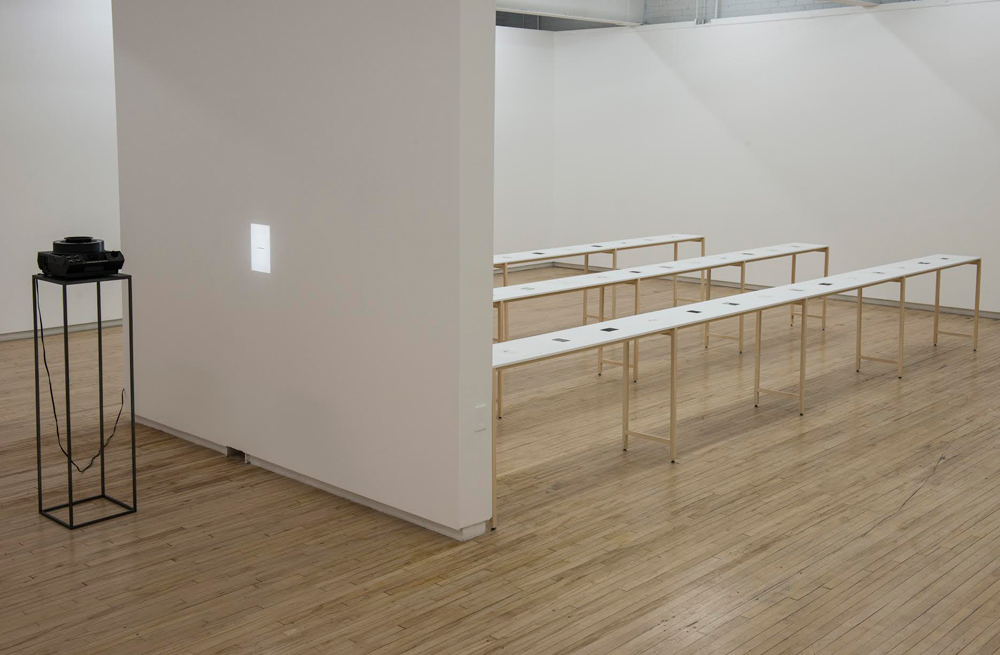“How many sentences can one create out of the twenty-six letters of the alphabet? How many meanings can one glean from hundreds of weeds, clods of dirt, and other trifles?” Witold Gombrowicz‘s questions come to mind when viewing Sophie Jodoin‘s current solo exhibition, “une certaine instabilité émotionnelle,” at Battat Contemporary. Evenly spaced across long, custom-built tables are 42 images from an ongoing series first started in 2013. Their encyclopaedic array invites a process of examination not dissimilar from the one undertaken by the protagonist of Gombrowicz’s novel, Cosmos (1965). When he rents a room in a countryside family home, the hero, also named Witold, fashions himself into a sort of metaphysical detective. He ekes out meaning from arrows implied in the stucco ceiling, a pencil dangling on a scrap of string and other such “clues,” until he is finally led to mould reality into the narrative he devises. Gombrowicz’s alphabet question is fundamentally about creating meaning in a world of disparate objects. What sort of categories do things fall into? Is there order in chaos?
Just like the idiosyncratic clues Witold latches onto, Jodoin’s images are more akin to remnants than objects: a crumpled piece of paper, the plastic tab that seals a bread bag, an arm, a list, an offset square. They are never complete in and of themselves but discarded fragments, bits and pieces of an implied but never fully articulated narrative. The small, meticulously crafted black-and-white images look closer to evidence than art. They are carefully placed specimens, centred perfectly on off-white sheets of paper. They aren’t made for viewing so much as forensic inspection.
As the show’s title suggests, the images have a quality that is hard to name. There is an uneasy melancholy, a sense of loss or perhaps even nostalgia. They look like xerox copies or photographs though they are, by and large, drawings mixed with print and collage. However, it is never easy to distinguish one medium from another. Using traditional drawing tools, Jodoin replicates the interlacing of a video still, the smear of photocopy toner or the blur of a camera. She portrays traces of objectivity as an aesthetic choice rather than an empirical value. This “evidence” is as much testimony to her process as it is a fragment of an imagined narrative. It creates a sense of what Jodoin has referred to as a feeling of disquietude, that subtle, unnerving something found in an unconscious movement or an awkward pause.
Jodoin’s visual vocabulary comes from years of amassing objects and images to form an accumulation rather than a well-ordered collection. She also accumulates text. Sentence fragments, words and letters are cut from books and magazines, and then rearranged in ways that speak to the contingency of meaning. For “une certaine instabilité émotionnelle,” Jodoin presents a series of 80 questions that read like a paranoid self-diagnosis questionnaire: “Votre langue se colle-t-elle à vos dents? Votre mâchoire est-elle serrée? Votre dépendance est-elle affective?” They are presented using an almost obsolete technology, a slide carousel, where images tick one past another in an automatized, perpetual loop. Each question is photographed on its slip of paper, centred against a white plane and projected at close range. The surface quality of the image strangely emulates Jodoin’s renderings in charcoal and conté. Projected at just slightly below viewing level, one must lean in to inspect them.
As the questions complete their cycle, their sheer number renders them rhetorical. In their attempt to identify a set of symptoms, they don’t point toward an illness but to that which cannot be fully diagnosed. They speak to the inarticulable, and to the role of language in creating, rather than expressing, meaning.
“We make up sentences, but nothing is really said,” writes Céline Andréa Huyghebaert in an ongoing artwork-cum-exhibition text produced at the invitation of the artist. Huyghebaert engages in a series of self-led writing residencies in the gallery where, like Witold in Cosmos, she narrates a potential story from her personal observations, feelings and experiences. Her text forms a parallel universe that relates to, but remains separate from the evidence around her. Jodoin’s fragments, freely mixing the visual and linguistic vocabularies of science and art, also underscore the uncertain boundaries of narrative, representation and reality. We cannot see beyond the symbols, orders and modes by which we create meaning, but, in stretching the limits of their use, we can point toward their instability.









